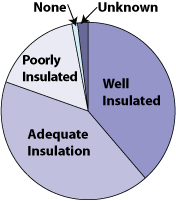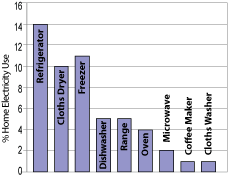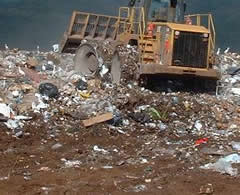 Meet the Joules family
Meet the Joules family
Forest and Kelly Joules, and their children Olive and Teal, are ready to make some changes to conserve energy and reduce the amount of carbon dioxide (CO2) and other greenhouse gases they add to the atmosphere.
Your job is to help them decide which changes they are going to make. Sometimes just a few changes can make a big difference in the amount of heat-trapping gases are released. You will also be able to keep an eye on how much these changes costs and how much money they save the family in the long run.
"Thanks for your help!" Olive Joules shouts.
"Yeah, we really need it," mutters Teal, rolling his eyes.
"We're not that bad to the environment, are we?" Kelly asks Teal.
"I guess we'll see!" Forest chuckles.
Through the tabs above, you can read about how the Joules family uses energy and produces CO2 - at home, through transportation, with food, and with their waste. Then you can make changes to the family in each section.
Not sure which changes to make? Peruse the panels at the right in each tab for more information about energy use and greenhouse gas emissions.
The changes you make for the Joules family will change the meters on the dashboard at the top of the screen. For more information about what these meters are measuring, see the "About this scenario" tab.
Home energy use statistics
 It takes 94.9 million Btu to power the average American household. It would take over 16 barrels of crude oil, 765 gallons of gasoline, or nearly 5 tons of coal to produce this much energy. What’s all that energy for? The pie chart at the left shows how energy is used at home.
It takes 94.9 million Btu to power the average American household. It would take over 16 barrels of crude oil, 765 gallons of gasoline, or nearly 5 tons of coal to produce this much energy. What’s all that energy for? The pie chart at the left shows how energy is used at home.
Where does electricity come from?
 Electricity comes from renewable sources such as hydroelectric dams, wind turbines, and solar panels, and nonrenewable sources such as coal, natural gas, petroleum, and nuclear. Power generation by renewables and nuclear doesn’t produce greenhouse gases. The chart at left shows where, on average, US electricity came from in 2008.
Electricity comes from renewable sources such as hydroelectric dams, wind turbines, and solar panels, and nonrenewable sources such as coal, natural gas, petroleum, and nuclear. Power generation by renewables and nuclear doesn’t produce greenhouse gases. The chart at left shows where, on average, US electricity came from in 2008.
Energy used for heat
 Most homes in the US use electricity or natural gas to stay warm. The pie chart at left shows the percentage of US homes heated with different fuels.
Most homes in the US use electricity or natural gas to stay warm. The pie chart at left shows the percentage of US homes heated with different fuels.
Energy used for AC
82% of US homes have some type of air conditioning. The average US home uses 9.6 million Btu for air conditioning per year. AC is used more in warmer places. A household in the southern US uses about six times as much energy for AC than a household in New England.
Turning down the heat
Installing a programmable thermostat and turning down the heat from 70F to 62F at night and midday in winter can save $125 per year in heating cost and save over 16,000 pounds of CO2 from the atmosphere over the life of the thermostat, according to US EPA and DOE estimations.
Home size and energy demand
American home size has grown over the past few decades. With larger homes, there is more demand to heat and cool interior spaces. The median size of new single-family houses sold in the U.S. has increased 42% during the past 20 years - from 1,650 square feet in 1978 to 2,335 square feet in 2007 (National Association of Home Builders)

Insulation and energy use
 Adding insulation and sealing the gaps in a typical house can save up to 20% of heating and cooling costs. This estimate is made by the US EPA based on energy modeling for a typical three bedroom home with 1500 square feet. Is there enough insulation in your home? According to an EIA survey, more than half of US homes could use more insulation and about 40% have drafty gaps.
Adding insulation and sealing the gaps in a typical house can save up to 20% of heating and cooling costs. This estimate is made by the US EPA based on energy modeling for a typical three bedroom home with 1500 square feet. Is there enough insulation in your home? According to an EIA survey, more than half of US homes could use more insulation and about 40% have drafty gaps.
CFL bulbs and energy use
 A compact florescent light bulb (CFL) last longer and use about a quarter of the energy as incandescent bulbs. While CFLs are more expensive than incandescent bulbs, they typically pay for themselves in 4-5 months of energy savings. They contain a small amount of mercury, so make sure you recycle them instead of putting them in the trash.
A compact florescent light bulb (CFL) last longer and use about a quarter of the energy as incandescent bulbs. While CFLs are more expensive than incandescent bulbs, they typically pay for themselves in 4-5 months of energy savings. They contain a small amount of mercury, so make sure you recycle them instead of putting them in the trash.
Stand-by appliances and energy use
Stand-by appliances use energy when they are switched off or not in use. Almost anything that has a remote control, has an external power source, or charges batteries is a stand-by appliance.
How much energy can a computer & monitor use?
A desktop computer with an LCD screen, speakers, and an inkjet printer draws 115 watts when on, 42 watts when in sleep mode, and 11 watts off. All those watts add up. If you leave the computer on all the time for a year it adds up to more than 1000 kWh of electricity. If you leave it in sleep mode it uses nearly 400 kWh of electricity. Turned off, these devises still use a little electricity which adds up to about 100 kWh over a year.
Common household appliances and energy use
Refrigerators consume more electricity than other household appliance: 4.6 million Btu per household. Other appliances and lighting consume 24.7 million Btu per household. Some of the most consumptive appliances are cloths dryers, freezers, and TVs.

Easy changes to water heaters
 Insulating the hot water heater is a low-cost way to decrease the amount of energy that goes to heating water, saving 4%–9% on water heating costs. The simplest thing that can be done, although its impact isn’t huge, is to reduce the water temperature. For each 10ºF reduction in water temperature, you can save between 3%–5% in energy costs.
Insulating the hot water heater is a low-cost way to decrease the amount of energy that goes to heating water, saving 4%–9% on water heating costs. The simplest thing that can be done, although its impact isn’t huge, is to reduce the water temperature. For each 10ºF reduction in water temperature, you can save between 3%–5% in energy costs.
Changing the water heater
 Changing your water heater can save energy. Solar hot water heaters cost more but have a huge impact on reducing greenhouse gas emissions. With a solar hot water system, water heating bills drop 50%–80%. On-demand tankless hot water heaters are also an energy efficient option, being 24%–34% more efficient than conventional water heaters.
Changing your water heater can save energy. Solar hot water heaters cost more but have a huge impact on reducing greenhouse gas emissions. With a solar hot water system, water heating bills drop 50%–80%. On-demand tankless hot water heaters are also an energy efficient option, being 24%–34% more efficient than conventional water heaters.
 Energy Use in the Joules Family Home
Energy Use in the Joules Family Home
Like the American average, a bit over 40% of the Joules family's home energy goes to heating, about 10% goes to air conditioning, about 20% to water heating and the rest for lighting and appliances.
The electricity used to power the Joules family's home comes from a utility company that makes energy with a mix of sources including fossil fuels like coal and natural gas which release CO2. To make the electricity used in the Joules home releases about 40,000 pounds of CO2 each year. What would you like to do to lower that number?
Currently the Joules family produces over 19,500 pounds of CO2 heating and cooling their home. How would you like to change the way the Joules family uses heat and air conditioning?
The Joules family produces over 13,000 pounds of CO2 with lights and appliances. Which change would you make to the Joules family to reduce these emissions?
The Joules family produces about 7,500 pounds of CO2 heating the water used for showers and baths, and washing dishes and clothes with their electric hot water heater. How would you decrease greenhouse gas emissions and still let them take hot showers?
Transportation and greenhouse gases
 Transportation accounted for 28% of US greenhouse gas emissions in 2007. About a third of that was from cars, a little less than a third for SUVs, pickup trucks and vans. For a typical household, transportation makes up more than half of energy use.
Transportation accounted for 28% of US greenhouse gas emissions in 2007. About a third of that was from cars, a little less than a third for SUVs, pickup trucks and vans. For a typical household, transportation makes up more than half of energy use.
Air travel and greenhouse gases
In 2007, US commercial aircraft emitted 155.2 Tg CO2 Equivalent. Wondering how much carbon dioxide your next flight will generate? Take a look at the airline carbon emissions calculator from Travel Analytics and find out.

Greener jet fuel?
Studies are looking at alternatives to traditional kerosene jet fuel. Hydrogen powered aircraft may be possible, but would have to be larger to accommodate the fuel and the planes would emit large amounts of water vapor, another greenhouse gas. Biofuels may be another option, although it’s not certain whether the greenhouse gas savings would be that high due to emissions during the production process.
Greener jet engines?
 Commercial aircraft were responsible for 8% of US greenhouse gas emissions in 2007. Modern jet aircraft are 70% more fuel efficient than they were 40 years ago due to improvements in the frame and the engine.
Commercial aircraft were responsible for 8% of US greenhouse gas emissions in 2007. Modern jet aircraft are 70% more fuel efficient than they were 40 years ago due to improvements in the frame and the engine.
US Automobile Statistics
The average American household has two cars and emits more than 20,000 pounds of CO2 per year driving them. CO2 emissions from passenger cars and light-duty trucks totaled 1147 Tg in 2007, an increase of 21% from 1990.
Change in US autos over time
 Between 1990 and 2007 transportation emissions rose 29%, the number of miles driven by cars and light trucks increased 40%, and average fuel economy of new vehicles dropped.
Between 1990 and 2007 transportation emissions rose 29%, the number of miles driven by cars and light trucks increased 40%, and average fuel economy of new vehicles dropped.
Gas mileage
 Every gallon of gasoline your car burns releases 20 pounds of CO2 into the atmosphere. That’s just one of the many reasons for driving a fuel efficient car. The most fuel efficient cars get up to 45 mpg on the highway while the least fuel efficient cars and SUVs get only 14 mpg on the highway. Visit the fueleconomy.gov web site to compare mileage.
Every gallon of gasoline your car burns releases 20 pounds of CO2 into the atmosphere. That’s just one of the many reasons for driving a fuel efficient car. The most fuel efficient cars get up to 45 mpg on the highway while the least fuel efficient cars and SUVs get only 14 mpg on the highway. Visit the fueleconomy.gov web site to compare mileage.
Commuting by car
 According to a 2001 survey, the largest proportion of vehicle miles traveled (27%) were to get to and from work. Between 1980 and 2000 the number of people who drove to work alone increased from 64.4% to 76.3%
According to a 2001 survey, the largest proportion of vehicle miles traveled (27%) were to get to and from work. Between 1980 and 2000 the number of people who drove to work alone increased from 64.4% to 76.3%
Tire pressure and mileage
 Tire pressure – for every pound of pressure below recommended levels, fuel economy drops 1%.
Tire pressure – for every pound of pressure below recommended levels, fuel economy drops 1%.
The way you drive affects gas mileage
Rapid acceleration can lower gas mileage as much as 33% on the highway and 5% in town. Speeding just 5 mph on the highway leads to an average fuel economy loss of 6%.

Emissions from gasoline and diesel
Gasoline has 2,421 grams of carbon per gallon. Diesel has 2,778 grams of carbon per gallon. This leads to CO2 emissions of 19.4 pounds per gallon of gasoline and 22.2 pounds per gallon of diesel.
Fuel cell cars
 Fuel cell cars might be widely available as soon as 2010. They are propelled by an electric motor which is powered by a fuel cell which makes electricity by chemical reaction of hydrogen and oxygen. Research continues on whether fuel cell vehicles might be the way of the future. At this point there are challenges in terms of on-board hydrogen storage, cold weather operation, safety and cost.
Fuel cell cars might be widely available as soon as 2010. They are propelled by an electric motor which is powered by a fuel cell which makes electricity by chemical reaction of hydrogen and oxygen. Research continues on whether fuel cell vehicles might be the way of the future. At this point there are challenges in terms of on-board hydrogen storage, cold weather operation, safety and cost.
Electric cars
 Electric cars, which have been around for decades in small numbers, have electric motors and rechargeable battery packs. Driving an electric car generates no greenhouse gases if the electricity does not come from fossil fuels. However, most electric cars can only go half as far as a typical car before needing a recharge. Plus the batteries are bulky and expensive.
Electric cars, which have been around for decades in small numbers, have electric motors and rechargeable battery packs. Driving an electric car generates no greenhouse gases if the electricity does not come from fossil fuels. However, most electric cars can only go half as far as a typical car before needing a recharge. Plus the batteries are bulky and expensive.
Green gasoline
Biofuels, made from plants, are in theory carbon neutral because they take in CO2 as they grow, which is released as the fuel burns, and then is taken in again as more plants are grown. But its production takes energy. There is debate over whether corn-based ethanol is saving CO2. Recently, scientists have been able to make gasoline from switchgrass and poplar trees, which take less energy to produce than ethanol. In five to 10 years it may be available at the pump.
 The Joules Family Is on the Move!
The Joules Family Is on the Move!
The Joules family's three cars emitted nearly 37,000 pounds of CO2 (16.7 tons) last year. The SUV that Kelly drives to work and that the family takes on road trip vacations gets 14 mpg. She drives 20 miles to work each weekday. In total, they drove the SUV 16,000 miles in the past year. How would you like to change Kelly's SUV use?
Forest drives a small sedan 20 miles to work in the opposite direction from Kelly and picks up Teal from middle school on his way home. The car gets 33 mpg, but it could be higher if Forest remembered to check the tire pressure more often. In the past year he drove 12,000 miles.
How would you like to change Forest's sedan use?
Olive got her license a year ago. She drives an old station wagon that gets 18 mpg to school and around town with her friends. No one told her that accelerating rapidly costs you gas mileage. She likes to speed too, and has racked up three tickets so far. In the past year she drove 7000 miles.
How would you like to change Olive's station wagon use?
The Joules family travels by plane too. Last year, Forest Joules had four business trips, the family flew to visit Grandma Viridian, and Forest and Kelly took a trip to Paris. Those flights burned lots of jet fuel, creating nearly 30,000 pounds of CO2.
Which change would you like to make to their flying?
Food's footprint
 Energy is used to grow the food, to transport it, to process it, and package it. The food sector accounts for roughly 25% of America’s ecological footprint. However, when making choices about which foods to buy, it is not always clear which choice is less energy intensive. Should you go for local food that is conventionally grown, or organic foods that were grown far away and transported? The sections below give more detail about the energy impact of food choices.
Energy is used to grow the food, to transport it, to process it, and package it. The food sector accounts for roughly 25% of America’s ecological footprint. However, when making choices about which foods to buy, it is not always clear which choice is less energy intensive. Should you go for local food that is conventionally grown, or organic foods that were grown far away and transported? The sections below give more detail about the energy impact of food choices.
Packaging of foods and energy
It takes energy to make packaging. For example, according to the Pacific Institute, it took approximately 17 million barrels of oil to produce the plastic for bottled water consumed by Americans in 2006 – enough energy to fuel more than 1 million American cars and light trucks for a year. This produced more than 2.5 million tons of CO2. If you include the impact of shipping the bottles of water brings this to 50 million barrels of oil equivalent.

Processed foods and energy
Processing food takes energy. Additionally, the ingredients to make a processed food may come from many different places, so there is energy used to transport the ingredients to the factory where the processed food is made. Many processed foods also come in extensive packaging. It takes energy to make such processing and petroleum is often a building block used to make plastic packaging.

Local foods
The average supermarket product travels 1,500 miles to reach the shelf. That’s 25% higher than 2 decades ago. Less transportation often means less energy is used. However, there are a lot of variables. How the food is transported (air, boat, truck) and how it is grown impact the energy consumption and greenhouse gases.

What's in season?
Eating foods that are in season in your area is a good way to ensure you are eating foods from local sources and saving the fossil fuels used to transport food from region to region and even around the world. Eating what’s in season means that you can’t eat anything at any time of the year. For example, the strawberries on the left ripen in the spring in many areas while the squashes on the right are ready in the fall. Also, eating foods that are in season in your area means that they were probably not grown in a greenhouse which has to be heated.

Organic foods & greenhouse gas emissions?
 There is still debate about whether organic foods produce less CO2 than conventionally grown foods. It is clear that some farming methods are less energy intensive than others and some organic farming methods appear to have minimal emissions.
There is still debate about whether organic foods produce less CO2 than conventionally grown foods. It is clear that some farming methods are less energy intensive than others and some organic farming methods appear to have minimal emissions.
Organic farming eliminates the need for chemical pesticides and fertilizers, which take energy to produce and have negative effects on the ecosystems. Without chemical fertilizers and using farming methods like crop rotation, organic farms can bring carbon into the soil rather than releasing it into the atmosphere.
Animal sources of food and energy
A meat-based diet takes more energy to produce than a plant-based diet, about four times as much energy. Converting natural lands into pasture decreases amount of CO2 taken out of the atmosphere. Most farm animals in the US are fed primarily corn, which takes a large amount of fossil fuel to grow, harvest, and transport. Manure releases the greenhouse gas methane, the second largest contributor to global warming.

Meat and methane gas
Half of all methane produced comes from agriculture, 18% from burps of cows, sheep, and goats. Manure creates a lot of methane when it is collected into large tanks or ponds, used where animals are kept in close quarters. On the bright side, methane is a source of energy. If the methane from US farms was utilized for energy, it could power nearly 6000 homes.

 Food, Energy, and CO2
Food, Energy, and CO2
"How much energy does it take to make food and to get it to a market?" Olive ponders, eyeing a box of cookies.
"It's complicated," says Teal, his voice muffled with crumbs. Here are a few examples from the Joules family's kitchen.
Packaging: The family stays hydrated by drinking bottled water, lots of it. Each week they buy two 24-packs of bottled water. They are definitely getting their eight glasses a day. What they are also getting is a larger carbon footprint.
Choose how much bottled water the Joules family will buy.
Local food: The Joules family doesn't get any of their food from local sources and they don't know when fruits and vegetables are in season in their area. They buy mostly processed food that is often imported from other countries. Choose how much of the Joules family's food will come from local sources.
Food from animal sources: The Joules family eats an average American diet, which includes about 28% of calories from animal sources. That includes meat and fish, and it also includes dairy products like milk, cheese, and ice cream as well as eggs. Will you change the Joules family's diet?
General waste statistics
In 2007, Americans made approximately 254 million tons of trash and recycled and composted 85 million tons of material. That’s a 33.4% recycling rate. On average we make 4.6 lbs of waste per person per day, and recycle 1.5 pounds of that.
Recycling saves energy and decreases greenhouse gas emissions. The 85 million tons recycled in 2007 reduces methane emissions by the equivalent of 193 million metric tons of CO2.

How methane is made in landfills
 In 2007, 137 million tons of waste was discarded in landfills and US landfills generated over 132 million metric tons of CO2 equivalent of methane, a very powerful greenhouse gas. Methane is released from landfills by rotting organic material in anaerobic conditions. Anaerobic bacteria produce CO2 and CH4 as they convert the waste into materials they are able to consume. Composting of organic material instead of sending it to a landfill decreases amount of methane released (see composting section below.) Unused methane is often burned off in a flare like the one in this picture, releasing a less potent CO2 to the atmosphere. Some flares are no longer used because the methane is now burned as an energy source.
In 2007, 137 million tons of waste was discarded in landfills and US landfills generated over 132 million metric tons of CO2 equivalent of methane, a very powerful greenhouse gas. Methane is released from landfills by rotting organic material in anaerobic conditions. Anaerobic bacteria produce CO2 and CH4 as they convert the waste into materials they are able to consume. Composting of organic material instead of sending it to a landfill decreases amount of methane released (see composting section below.) Unused methane is often burned off in a flare like the one in this picture, releasing a less potent CO2 to the atmosphere. Some flares are no longer used because the methane is now burned as an energy source.
Recycling rate
The US recycling rate in 2007 was 33.4% on average, meaning that about a third of the items that were discarded were recycled. Overall, the percent of materials recycled has gone up steadily between 1980 and 2007. However, in some communities the recycling rate is 60-70% while in others it is less that 10%.

Composting
 Composting is the process of breaking down organic materials (like leaves, carrot peelings, coffee grounds, paper). Composting limits the amount of methane released into the atmosphere from rotting organic material. It does this by allowing microbes to break down the waste in aerobic conditions (with oxygen). This is unlike the anaerobic conditions (without oxygen) that lead to the production of methane. Composting does release carbon dioxide to the atmosphere, but no more than the plants that are decomposing took out of the atmosphere as they grew - a normal part of the carbon cycle. The resulting composted material can be added to garden soil as a natural fertilizer.
Composting is the process of breaking down organic materials (like leaves, carrot peelings, coffee grounds, paper). Composting limits the amount of methane released into the atmosphere from rotting organic material. It does this by allowing microbes to break down the waste in aerobic conditions (with oxygen). This is unlike the anaerobic conditions (without oxygen) that lead to the production of methane. Composting does release carbon dioxide to the atmosphere, but no more than the plants that are decomposing took out of the atmosphere as they grew - a normal part of the carbon cycle. The resulting composted material can be added to garden soil as a natural fertilizer.
Waste reduction
Recycling and composting are great, but the best way to lower the amount of waste that goes to landfills is to make less waste. Reducing the amount of waste generated is called source reduction. Reducing the amount of packaging on the products you buy is a great way to start reducing your waste.

 Waste and Greenhouse Gas Emissions
Waste and Greenhouse Gas Emissions
"Trash can make tons of greenhouse gas," states Teal.
"But wait a minute. Garbage can't be burning fossil fuels. How does it make greenhouse gas?" asks Olive.
Landfill waste makes methane, a powerful greenhouse gas. The amount of methane produced, described here as CO2 equivalent, depends on the amount of waste. Recycling and composting reduce the amount of waste sent to landfills, so reduce the greenhouse gas emitted.
The Joules family makes about the same amount of waste as an average American family: 4.6 pounds of waste per person per day. All that garbage adds up. Over the past year it means that the Joules family has thrown away 6716 pounds of waste.
About 10% of what the Joules family threw away was recycled. The other 90% went to a landfill. The trash that the Joules family sent to the landfill over the past year makes an amount of methane equivalent to 1.63 tons of CO2.
Change the amount that the Joules family recycles and composts and see how much greenhouse gas is saved from the atmosphere.
About the Dashboard Meters:
CO2 Saved per Year: pounds of carbon dioxide that you have saved from the atmosphere each year by making changes to the Joules family’s lifestyle.
For the waste category this meter is measuring CO2 equivalent because landfills generate methane, another greenhouse gas. The amount of methane is converted to an equivalent amount of CO2 (an amount that would produce the same level of warming).
Home Energy Savings: kilowatt-hours per year (kWh/yr) of electricity saved by making changes to the Joules family’s home and the way they live in it.
The Joules family’s home, like approximately half of American homes, is powered entirely with electricity. It is also common in the US to have furnaces and hot water heaters powered with natural gas.
Gasoline Saved per Year: gallons of gasoline saved each year by making changes to the vehicles that the Joules family drives, the amount they drive, and how they drive.
This meter does not include the jet fuel saved by changing the family’s flying habits. It also does not include any gasoline saved by eating local foods. There is still debate about how much gasoline may be saved by eating local foods as so much depends on how the food is transported.
The Money Bags Balance: general amounts of initial monetary investment (on the left side) versus overall savings (right side). Of course, the hope is that either the investment will be matched by a similar moneybag of savings, or that savings will be greater than investment.
The money bags on this balance show cumulative cost and savings. This means that as you go through the scenario and make more choices to change the Joules’ lifestyle the moneybags on both sides will increase with each additional cost and savings.
I'm Done!
Thanks for trying to help Forest, Kelly, Olive and Teal Joules make changes to conserve energy and reduce the amount of carbon dioxide and other greenhouse gases they add to the atmosphere. Before you click the "I'm Done" button below, make sure you have visited and made decisions within the home, transportation, food, and waste categories. The list at the right summarizes the decisions to be made in each category.
Of course there are many more choices that one can make that help save greenhouse gases from the atmosphere. This scenario focuses on just a handful. But even a handful can make an impact. Once you have made a choice for each, click the button below to review the choices you made and how they impact greenhouse gases, energy use, fossil fuels and the Joules family’s budget.

|
In the house category, there were three decisions to be made:
- Heat and air conditioning
- Lights and appliances
- Water heating
In the transportation category, there were four decisions to be made:
- Kelly's SUV
- Forest's sedan
- Olive's wagon
- Plane flights
In the food category, there were three decisions to be made:
- Plastic bottles
- Local food
- Food from animal sources
And in the waste category there was one decision to be made. |